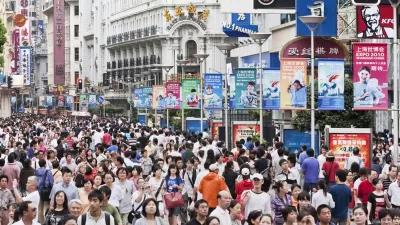An interactive visualization recently released by Unicef presents a startling picture of the world's urban population growth from 1950 to 2050. Mark Wilson deconstructs its implications.
Produced by Unicef, with the help of design studio Periscopic, "An Urban World" shows urban population growth in 10 year increments looking backwards and forwards.
Other than the astounding predicted growth that can seen in the urban populations of the developing world, another important statistic provided by the map is the percentage of each country's overall population that is urban. By 1990, 75% of the population of the United States, for instance, lived in cities. By comparison, Wilson notes that "China and India swell to astounding proportions without reaching our general city density. By 2050, somewhere between 50-75% of their population will live in cities. In other words, the India and China of tomorrow look a lot like the U.S. from the 1980s."
"Now, whether this ends up being a good or bad thing--whether we're talking about urban slums or smartly scaled communities, loosely populated expanses of efficient agriculture, or underdeveloped countrysides stricken by poverty--none of that is written on this map because none of that is written just yet. But it's hard to watch these bubbles grow, expanding into one another in a battle for your mere vision (let alone food, housing, and wages) and earnestly expect that everything is just going to be all right."
FULL STORY: By 2050, 70% Of The World’s Population Will Be Urban. Is That A Good Thing?

Study: Maui’s Plan to Convert Vacation Rentals to Long-Term Housing Could Cause Nearly $1 Billion Economic Loss
The plan would reduce visitor accommodation by 25,% resulting in 1,900 jobs lost.

North Texas Transit Leaders Tout Benefits of TOD for Growing Region
At a summit focused on transit-oriented development, policymakers discussed how North Texas’ expanded light rail system can serve as a tool for economic growth.

Why Should We Subsidize Public Transportation?
Many public transit agencies face financial stress due to rising costs, declining fare revenue, and declining subsidies. Transit advocates must provide a strong business case for increasing public transit funding.

How Community Science Connects People, Parks, and Biodiversity
Community science engages people of all backgrounds in documenting local biodiversity, strengthening connections to nature, and contributing to global efforts like the City Nature Challenge to build a more inclusive and resilient future.

Alabama: Trump Terminates Settlements for Black Communities Harmed By Raw Sewage
Trump deemed the landmark civil rights agreement “illegal DEI and environmental justice policy.”

Dear Tesla Driver: “It’s not You, It’s Him.”
Amidst a booming bumper sticker industry, one writer offers solace to those asking, “Does this car make me look fascist?”
Urban Design for Planners 1: Software Tools
This six-course series explores essential urban design concepts using open source software and equips planners with the tools they need to participate fully in the urban design process.
Planning for Universal Design
Learn the tools for implementing Universal Design in planning regulations.
City of Santa Clarita
Ascent Environmental
Institute for Housing and Urban Development Studies (IHS)
City of Grandview
Harvard GSD Executive Education
Toledo-Lucas County Plan Commissions
Salt Lake City
NYU Wagner Graduate School of Public Service



























